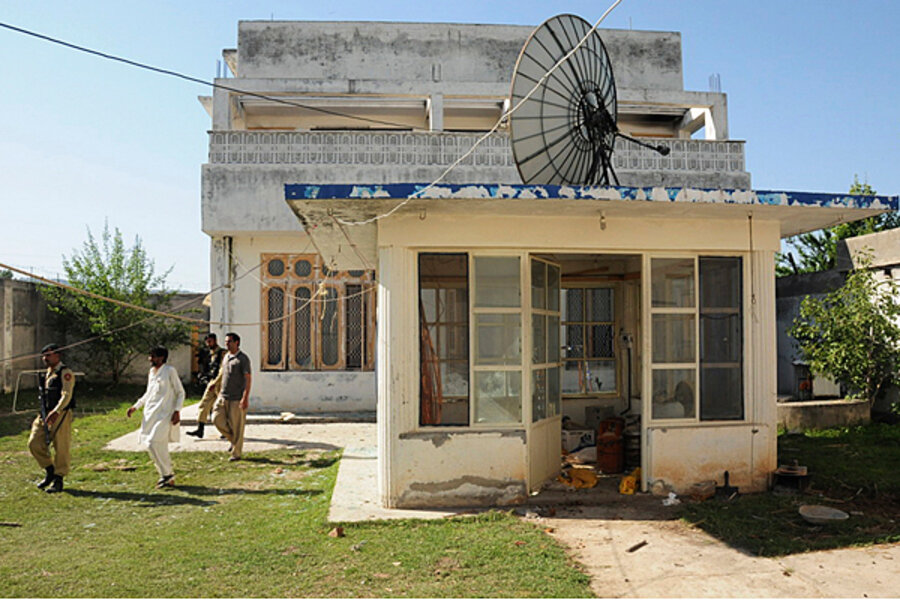Bin Laden widows charged as new probe describes life with Osama bin Laden
Loading...
| Islamabad, Pakistan
Pakistani authorities said Thursday that they had filed charges against Osama bin Laden's three widows as an investigation revealed fresh details of the dead Al Qaeda leader's family life in Pakistan, including suspicions by two of the women that the oldest wife would betray him.
The three widows, who have been in Pakistani custody since US forces found and killed Mr. bin Laden last May in the northern town of Abbottabad, had been expected to be freed until Pakistan's interior minister said they would be charged with crimes related to entering the country illegally.
The charges came as Shaukat Qadir, a retired brigadier who maintains ties to top levels of the Pakistani Army, claims to have pieced together the most comprehensive account yet of bin Laden's life after he fled Afghanistan's Tora Bora mountains in late 2001.
Mr. Qadir believes that bin Laden likely had undergone a kidney transplant, was living in effective retirement in Abbottabad and may have gone senile. The tranquility of his large household was shattered when it was joined early last year by the oldest of his remaining three wives, Qadir said in an interview.
There were 27 people packed into the house in Abbottabad when US Navy SEALs arrived on the night of May 2, 2011. But until a few months before that, when bin Laden's oldest surviving wife, Khairiah Sabar, joined them, they had all got on well, Qadir found.
"When Khairiah came, everybody else was very suspicious of her. They didn't trust her at all," Qadir said.
"Everything begins to happen with her arrival. Until then, the Americans seem to know nothing."
It was Khairiah who sold out bin Laden, Qadir said, although it wasn't clear whom she would have communicated with once inside. His account also is at odds with the story leaked by American officials, which contends that they found the Abbottabad house by following an Al Qaeda courier known as "al-Kuwaiti" to the home some time in the second half of 2010.
Qadir called the courier story "fictitious," but his full report, which has yet to be published, already has come under some criticism for its heavy reliance on Pakistani military sources.
Qadir said that he relied on notes of interrogations by Pakistani intelligence agents of bin Laden's wives, which were made available to him through his military contacts. He also conducted his own research. Qadir is known to be close to Pakistan's current army chief, Gen. Ashfaq Parvez Kayani, who arranged several visits for him to the Abbottabad compound, which was cordoned off by security forces after the US raid.
The compound was suddenly demolished, without explanation, by the Pakistani authorities late last month.
Who is Khairiah?
Khairiah, a Saudi whom bin Laden married in 1985 as his third wife (he married six times), was freed from Iranian custody in 2010 as part of a murky exchange for an Iranian diplomat who had been kidnapped by extremists in Pakistan. She made her way without her children to Abbottabad on bin Laden's instructions.
The other two wives, Siham, a Saudi, who had three adult children with her, and Amal, a Yemeni, who had five young children, had lived with bin Laden since he moved into the Abbottabad home in mid-2005. They also had been with him for periods at other hiding places in Pakistan after 2001, according to Qadir.
"Bin Laden didn't sleep with any of his other wives after marrying Amal," Qadir said.
At one point, when pressed by Siham's adult son Khalid about why she had come, Khairiah said it was because she had "one final duty" to perform for bin Laden. Qadir said that even bin Laden apparently feared that she would turn him in, but although he "kept telling" the other two wives to leave, they refused.
Qadir's theory of bin Laden's early retirement
Bin Laden may have had a kidney transplant in 2002, which would explain why his known kidney ailment did not require him to undergo dialysis treatment while on the run. Still, the disease apparently brought on senility. As a result, Al Qaeda's leadership council, or shura, sent him into an early retirement around 2003 in Pakistan, Qadir said.
That theory again contrasts with the view of some US officials, who say bin Laden stayed active in Al Qaeda's affairs and had some involvement in planning attacks in the West, as well as remaining a spiritual guide to the organization. However, it could explain childlike images that emerged on videotapes found at the Abbottabad house, with bin Laden sitting on the floor watching television with fascination.
The wives
Qadir's investigation has traced bin Laden's movements to several places in Pakistan; previously, only his stay in Abbottabad was known. In the early years after 2001, Qadir believes bin Laden was in South Waziristan, in the tribal area close to the Afghan border. He later traveled back into Afghanistan and then, in 2004, made his way into northern Pakistan's Swat area. After a few months spent farther south in Haripur district, he eventually moved into the Abbottabad home in May 2005.
The bin Laden wives have never been proven to be involved with Al Qaeda. Last year, Pakistan's official commission probing bin Laden's presence in the country recommended that the wives and children be sent home.
The reason for the charges against them now, for the relatively minor issue of not possessing Pakistani visas, wasn't immediately clear. Saudi authorities, who wield enormous influence in Islamabad, reportedly haven't been eager to take back their citizens.
The wives and children are being held at an undisclosed house in Islamabad. Rehman Malik, Pakistan's Interior minister, said they would now effectively be placed under house arrest.
"They are being kept in a proper legal manner," Malik said.







